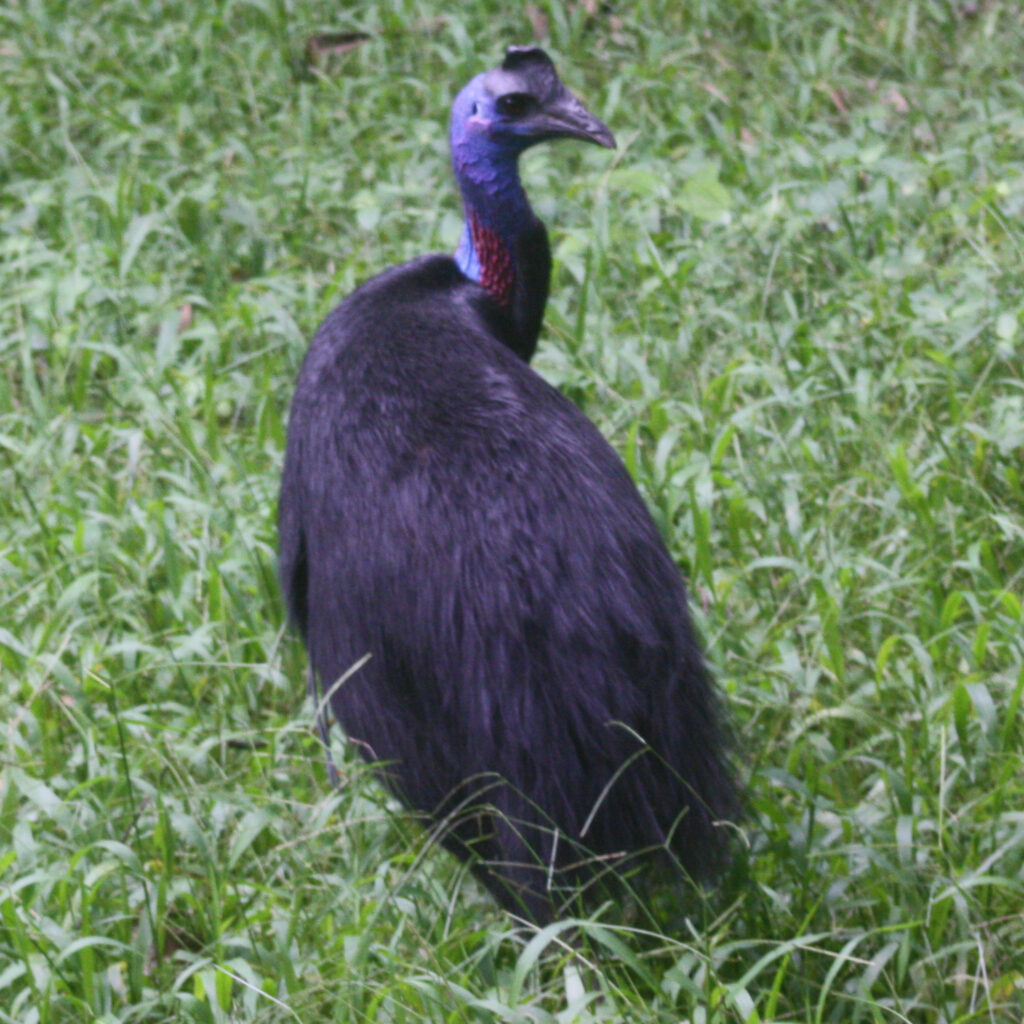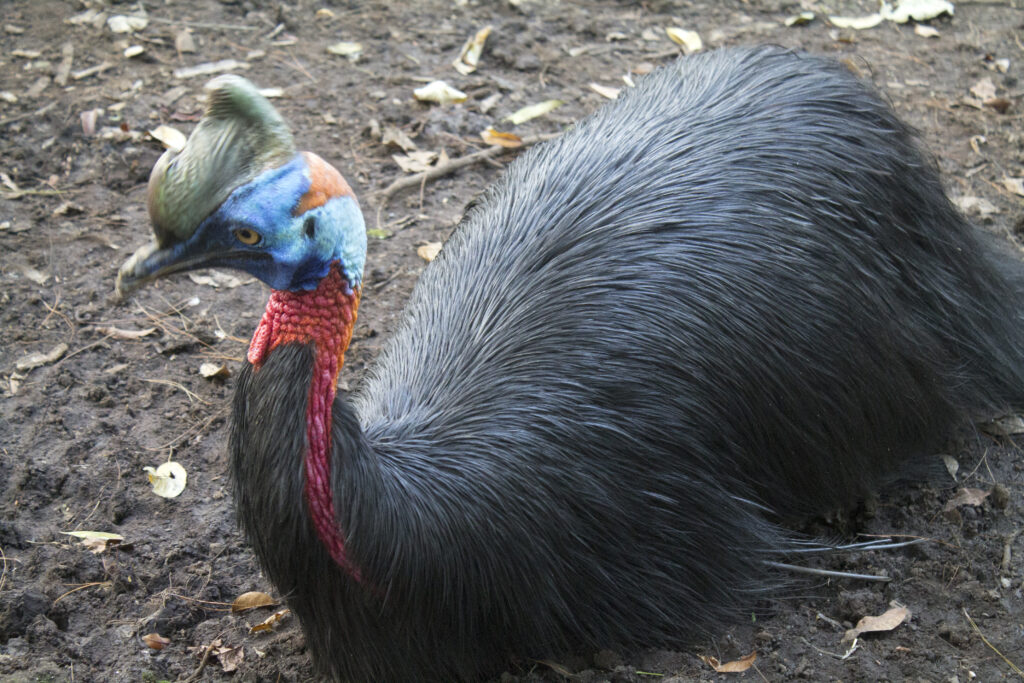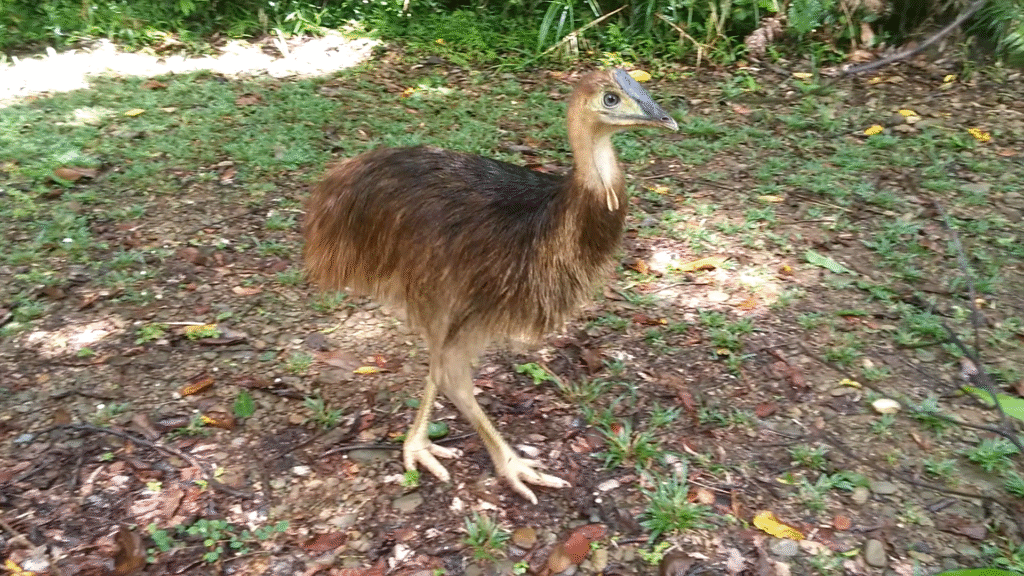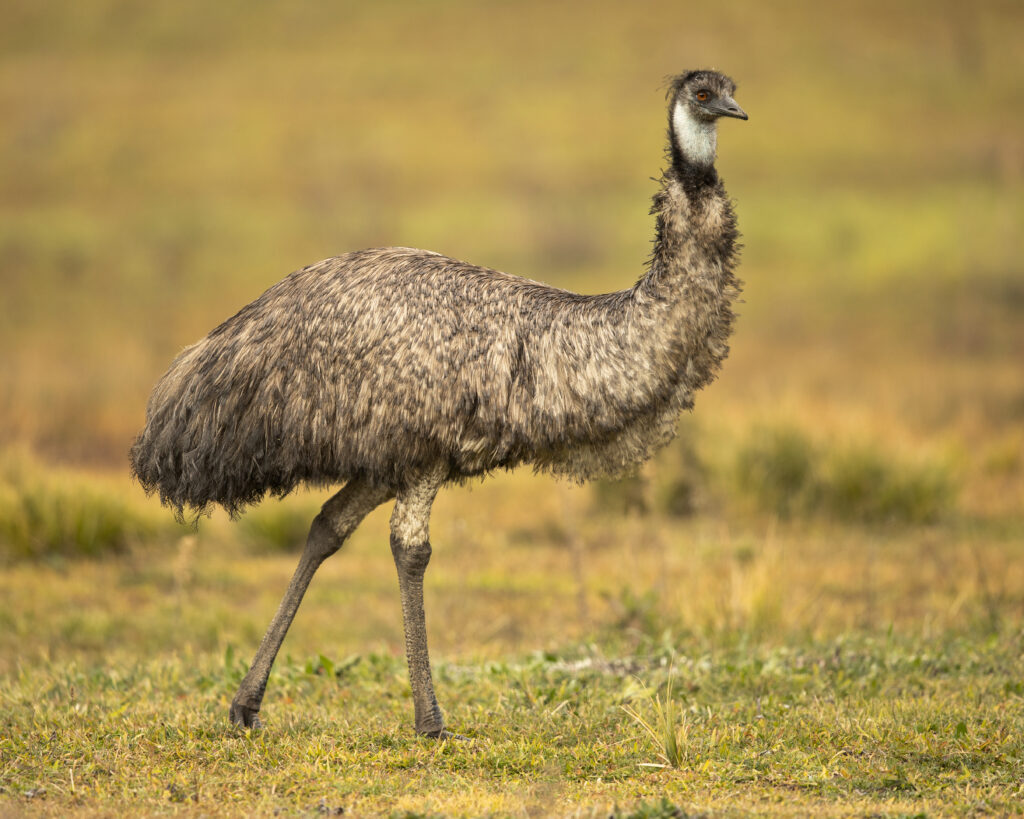In the dense rainforests of northeastern Australia, Papua New Guinea, and nearby islands, a creature stalks the undergrowth that seems like a visitor from Earth’s prehistoric past. Standing up to 6.5 feet tall, with brilliant blue necks, red wattles, and a distinctive helmet-like casque atop their heads, cassowaries are often described as “modern-day dinosaurs.” This isn’t merely poetic license – these flightless birds genuinely are among the closest living relatives to the dinosaurs that once ruled our planet. As descendants of theropod dinosaurs, cassowaries offer us a rare glimpse into an ancient world while facing very modern threats to their survival.
Ancient Origins: The Dinosaur Connection

Cassowaries belong to the ratite family of flightless birds, which includes emus, ostriches, and kiwis, all of which evolved from flying ancestors. Scientific evidence strongly supports that birds are the only living descendants of theropod dinosaurs, the group that included Velociraptors and Tyrannosaurus rex. The cassowary’s skeletal structure, with its three-toed feet ending in dagger-like claws, bears striking similarities to certain dinosaur species. Their prehistoric appearance is no coincidence – molecular studies suggest that the cassowary lineage diverged from other birds approximately 60 million years ago, not long after the mass extinction event that wiped out non-avian dinosaurs. When observing a cassowary’s powerful legs and dinosaur-like gait, we’re witnessing living evolutionary history, a direct connection to creatures that dominated Earth for over 160 million years.
The Three Species: A Family Portrait

The cassowary family comprises three distinct species, each with its own unique characteristics and geographic distribution. The Southern Cassowary (Casuarius casuarius) is the largest and most well-known, inhabiting the tropical rainforests of northeastern Australia, Papua New Guinea, and nearby islands. The Northern Cassowary (Casuarius unappendiculatus), recognizable by its single wattle, is native to northern New Guinea and nearby islands. The Dwarf Cassowary (Casuarius bennetti), the smallest of the three at around 3.3 feet tall, makes its home in the mountain forests of New Guinea, northeastern Australia, and New Britain. Despite their differences in size and specific habitat preferences, all three species share the distinctive casque, vibrant coloration, and powerful build that make cassowaries so instantly recognizable. Conservation efforts must address the unique needs of each species while recognizing their shared vulnerability to habitat loss.
Physical Marvels: Built for Survival

Cassowaries possess a remarkable set of physical adaptations that have helped them survive for millions of years. Their most distinctive feature is the casque – a helmet-like structure composed of keratin that sits atop their heads and can grow up to 7 inches tall. While scientists continue to debate its exact function, theories suggest it may serve as a resonating chamber for vocalizations, a protective helmet when moving through dense vegetation, or a display feature for attracting mates. The cassowary’s striking coloration includes a brilliant blue neck and face, contrasting with their black feathers and bright red wattles hanging from its neck. Their legs are incredibly powerful, capable of propelling them at speeds up to 31 mph through dense forest and launching kicks that can deliver fatal wounds with their 4-inch dagger-like claws. Perhaps most surprising is their waterproof black plumage, which resembles coarse hair more than typical bird feathers, an adaptation that helps them navigate their rain-soaked habitats.
The Rainforest Gardeners: Ecological Importance

Cassowaries play a vital role in maintaining the biodiversity of their rainforest ecosystems, earning them the title of “rainforest gardeners.” As frugivores, they consume the fruits of hundreds of plant species, including many with large seeds that other animals cannot digest or disperse. What makes cassowaries uniquely valuable is their digestive system, which processes fruit quickly while leaving the seeds intact and viable. This means seeds pass through their system unharmed and are deposited with natural fertilizer across the forest floor, often far from the parent tree. Some rainforest plants have co-evolved with cassowaries to such an extent that they depend entirely on these birds for seed dispersal, and germination – certain seeds require passage through a cassowary’s gut to trigger germination. Scientists estimate that a single cassowary may disperse over 100,000 seeds across its territory in a single year, making them an irreplaceable architect of forest regeneration and diversity.
Territory and Habitat: A Shrinking Domain

Cassowaries require large territories of dense rainforest to thrive, with individual birds establishing and defending areas ranging from 0.5 to 2.5 square miles. They prefer habitats with abundant fruit-bearing trees, understory vegetation for cover, and access to freshwater for drinking and bathing. The ideal cassowary habitat features a complex forest structure with a closed canopy to maintain the humid, relatively cool conditions they prefer. Unfortunately, these specific habitat requirements make cassowaries particularly vulnerable to forest fragmentation and clearing. In Australia’s Queensland, where the Southern Cassowary population is estimated at fewer than 4,000 individuals, habitat loss continues at an alarming rate due to agricultural expansion, urban development, and infrastructure projects. Conservation efforts increasingly focus on maintaining habitat corridors between fragmented forest patches, allowing cassowaries to move safely between feeding areas and maintain genetic diversity across populations.
Diet and Feeding Behavior: Fruit Connoisseurs

Cassowaries have earned a reputation as the rainforest’s fruit specialists, with fruits comprising up to 80-90% of their diet. These birds are opportunistic feeders, consuming fallen fruits from over 238 documented plant species and showing particular preference for colorful, fleshy fruits. Their feeding method is distinctive – using their powerful legs to kick leaves and debris aside as they search for fallen fruit, and then swallowing fruits whole, even those as large as apples. While primarily frugivorous, cassowaries supplement their diet with fungi, insects, small vertebrates, and even carrion when fruit is scarce, demonstrating impressive dietary flexibility. Their feeding behavior follows the seasonal fruiting patterns of the rainforest, causing them to travel widely within their territories as different trees produce fruit throughout the year. Interestingly, cassowaries have been observed remembering the locations of fruit-bearing trees and returning to them seasonally, suggesting sophisticated spatial memory capabilities.
The World’s Most Dangerous Bird: Fact vs. Fiction

Cassowaries have earned a fearsome reputation, often described in popular media as “the world’s most dangerous bird,” but the reality requires nuance. While these birds are indeed powerful and capable of inflicting serious injuries with their 4-inch dagger-like claws, unprovoked attacks on humans are extremely rare. Most documented cassowary attacks occur when the birds feel threatened, are protecting their young, or have been conditioned to associate humans with food through irresponsible feeding. The most serious case occurred in 1926, when a cassowary killed a teenager who had struck it with a club, and more recently in 2019, when a Florida man keeping a cassowary as a pet was fatally injured. Wildlife experts emphasize that cassowaries are naturally shy birds that prefer to avoid human contact and typically flee when encountered in the wild. The danger they pose has been sensationalized, while the far greater danger humans pose to cassowaries through habitat destruction receives comparatively little attention.
Reproductive Biology: Father Knows Best

Cassowaries exhibit one of the most fascinating reproductive systems in the avian world, with a complete reversal of traditional parental roles. The breeding season typically coincides with the peak fruit availability between June and October, when females become territorial and compete for male attention. What makes cassowaries remarkable is that after mating with several males and laying clutches of 3-5 large, bright green eggs for each, the female abandons her reproductive responsibilities entirely. The male cassowary assumes all incubation duties for approximately 50-60 days, hardly leaving the nest even to eat or drink. Once the chicks hatch, the father’s dedication continues for up to nine months, teaching the young cassowaries to forage, protecting them from predators, and even leading them through water to teach swimming skills. This reversed parental investment is rare among vertebrates and has fascinated evolutionary biologists studying the development of parental care systems.
Communication and Intelligence: More Than Meets the Eye

Despite their reputation as primitive creatures, cassowaries possess sophisticated communication systems and cognitive abilities. Their vocalizations range from deep booming calls that can travel through dense forest (aided by their casque as a resonating chamber) to high-pitched whistles and rumbling growls. These birds communicate through body language as well, with subtle movements of their casque, wattles, and neck conveying information about mood and intentions to other cassowaries. Recent studies suggest cassowaries may be more intelligent than previously thought, demonstrating problem-solving abilities when accessing food and remarkable spatial memory when navigating their complex forest habitats. They show individual personality differences, with some birds displaying greater curiosity or boldness than others. Perhaps most impressive is their apparent ability to recognize individual humans who regularly visit their territories, responding differently to those who have provided food versus those perceived as threats, indicating sophisticated social recognition capabilities.
Conservation Status: A Future in Jeopardy

All three cassowary species face significant threats, with the Southern Cassowary listed as Vulnerable on the IUCN Red List. In Australia, where fewer than 4,000 Southern Cassowaries remain, they’re considered Endangered under national environmental law. Habitat loss presents the greatest threat, with rainforest clearing for agriculture, urban development, and palm oil plantations destroying crucial cassowary territory. Road mortality is another significant issue, with cassowaries regularly killed by vehicles as they attempt to cross roads that fragment their habitat. Additional threats include attacks by domestic dogs, diseases, natural disasters like cyclones that destroy fruit-bearing trees, and the ongoing climate crisis altering rainforest ecology. Conservation efforts focus on habitat protection, installation of cassowary road crossing structures, rehabilitation of injured birds, and community education programs. Recovery plans emphasize the critical importance of maintaining connectivity between remaining forest fragments to allow genetic exchange between isolated cassowary populations.
Cultural Significance: Revered and Mythologized

For thousands of years, cassowaries have held profound cultural significance for the Indigenous peoples of Australia and New Guinea. In Aboriginal culture, the cassowary figures prominently in Dreamtime stories, often portrayed as a creator being who brought important foods to humans. Traditional laws governed cassowary hunting, with strict protocols about who could hunt them and how their meat, feathers, and bones could be used. In Papua New Guinea, cassowary feathers and bones remain important ceremonial items, while the birds feature in origin myths and are seen as symbols of strength and power. Young cassowaries are sometimes captured and raised by Indigenous communities, creating a complex human-wildlife relationship. Even in contemporary Australian culture, the cassowary serves as a powerful conservation symbol and tourist attraction, drawing wildlife enthusiasts from around the world to cassowary habitat areas like Mission Beach and the Daintree Rainforest. This cultural significance provides an important foundation for modern conservation efforts that seek to incorporate traditional knowledge and values.
Cassowary Conservation Initiatives: Working Toward Recovery

Numerous organizations and government agencies have implemented dedicated cassowary conservation programs across their range. The Australian Cassowary Recovery Team coordinates conservation efforts nationally, bringing together researchers, land managers, Indigenous groups, and community organizations. Key initiatives include the establishment of cassowary rehabilitation centers that nurse injured or orphaned birds back to health before releasing them into protected areas. Habitat buyback programs, funded by both government and non-profit organizations, purchase critical cassowary habitat to prevent development and create wildlife corridors connecting isolated forest fragments. Community-based initiatives encourage residents to plant cassowary food trees, drive carefully in cassowary areas, and properly secure garbage to prevent birds from associating humans with food sources. Many conservation projects employ innovative technologies, including satellite tracking of released birds, DNA analysis to monitor population health, and strategically placed wildlife cameras to document cassowary movements and behavior without human disturbance.
Living with Cassowaries: Guidelines for Coexistence

For communities sharing their environment with cassowaries, learning to coexist safely with these magnificent birds is essential. Wildlife authorities emphasize that feeding cassowaries is dangerous and counterproductive, as it associates humans with food and can lead to aggressive behavior when expectations aren’t met. When encountering a cassowary in the wild, experts recommend maintaining a respectful distance of at least 30 feet, backing away slowly if approached, and using an object like a backpack as a shield if a bird becomes aggressive. Drivers in cassowary country should observe reduced speed limits, particularly around dawn and dusk when the birds are most active, and report any cassowary sightings or incidents to local wildlife authorities. Residents of cassowary habitat areas are encouraged to keep dogs leashed or contained, as domestic dogs account for numerous cassowary injuries and deaths each year. Many communities in North Queensland have embraced their role as cassowary guardians, incorporating cassowary-friendly design elements into developments and celebrating these unique birds as living natural treasures.
Conclusion

The cassowary stands as a living link to our planet’s prehistoric past, a magnificent survivor that offers us profound insights into evolutionary history and ecological interdependence. As we face unprecedented biodiversity loss worldwide, these remarkable birds remind us of what’s at stake – not simply the loss of a single species, but the disruption of entire ecosystems that have evolved over millions of years. By protecting cassowaries and their rainforest habitats, we preserve not only living dinosaurs walking among us but also the intricate web of life they help sustain. The future of these extraordinary birds ultimately depends on our willingness to share our world with creatures whose presence long predates our own – a challenge that speaks to the very heart of conservation in the 21st century.




